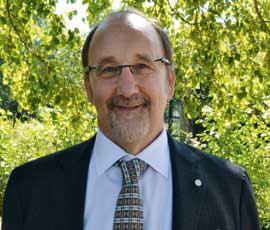Pesticide product research outlook good

As regulations tighten launches of new pesticides are becoming rare. David Jones sits down with the head of research at one of the world’s biggest manufacturers and hears a more optimistic message.
Agrochemical giant Bayer CropScience is confident that it can beat the industry’s average and launch more than one blockbuster product every year.
Tighter regulations have dried up the flow of new pesticides, but Bayer is hoping its new seed and biologicals businesses will help boost its overall pipeline.
Research chief David Nicholson (pictured above) says the group’s pipeline of new products looks strong and is positive about beating its rivals with big launches over the coming years.
“Agrochemicals are getting more difficult to get onto the market but we are compensating for that by looking into our tool box and using our biologicals, breeding and traits businesses,” he tells Farmers Weekly.
Bayer, second only to Syngenta in global agrochemical sales, has been investing heavily in seeds and biological products to bolster its traditional chemicals business.
Its annual Є800m (£672m) spend on research results in about 100 new broad-acre crop varieties, 100 new chemical formulations and more than one main new chemical or biological pesticide.
“We plan to beat the average industry figure of one major new product a year,” he adds.
Dr Nicholson says the group, based in Monheim on the Rhine in Germany, has a number of herbicides and fungicides in the pipeline, but suggests its next SDHI fungicide will not be for cereals.
He says the group is actively researching possible disease resistant strains to the SDHIs used in cereals, but a new cereals SDHI is several years off and would follow SDHIs for other crops.
“We are looking at a spread of technologies in order to grow our output across a number of crops,” he says.
This effort he hopes will put his group ahead of the other four agrochemical giants – Syngenta, DuPont, Dow and BASF – in the search for new novel products.
The group’s next big biological product is set to come in 2016 for the control of mites in soft fruit crops in California, which is proving just as efficient as more traditional chemical products.
This could be the first of a number of products which would be aimed a more mainstream crops and follows Bayer’s acquisition of California-based biological group AgraQuest in 2012.
The group says its future pipeline will include products to control soya bean cyst nematodes, while it aims to make a big push into soya bean and wheat breeding.
It expects the launches between 2010 and 2016 to see annual sales peak at Є4bn (£3.6bn), a sum equivalent to nearly half the group’s current turnover.
These will include insecticides, fungicides and herbicides with chemical and biological mode of action and also a number of seed launches.
While new products arrive, Dr Nicholson is confident about holding onto existing ones such as its triazole prothioconazole, as used in Proline, after this group of chemicals has come under threat.
The European Union is looking at whether triazoles can be classified as endocrine disruptors, which interfere with hormone levels in humans.
“We don’t think we are going to lose prothioconazole,” he says.
As the group searches for new products, it is doubling its annual capital expenditure on production plants to Є600m (£504) to keep pace with demand, with most of the new investments in Europe and North America.
Bayer is making its largest investment in agrochemicals in its 150-year history as part of this increased spend, with the building of a plant to make a glyphosate-alternative, glufosinate-ammonium, in Mobile, Alabama, USA.
This Є380m (£319m) spend will see the opening of this new plant by end-2015, and reflects the concern in North America about weed resistance building up against glyphosate.
Weed resistance is already affecting almost half the growers in the United States, while glyphosate resistance is being seen in the vineyards and olive groves of southern Europe.
Dr Nicholson argues that an alternative is needed and also that growers should use a range of herbicides mixed with cultivation techniques to try and prevent resistance building up.
Although CropScience is the smallest of Bayer’s three divisions, its underlying sales growth of 15.6% in 2012 clearly outpaces that seen in pharmaceuticals and chemicals.
That growth saw sales reach Є8.4bn (£7bn) last year and revenue is set to grow nearly 10% this year driven by growth around the globe.
EU bans pesticides linked to bee decline

